Hyperspectral Image Segmentation via Frequency-Based Similarity for Mixed Noise Estimation
Abstract
:1. Introduction
2. Parametric Noise Model
3. Proposed Mixed Noise Estimation Method for HS Images
3.1. Superpixel Segmentation
3.2. Selection of Homogeneous Superpixels
3.3. Approximation of SD and SI Noise Variances
4. Experimental Results and Discussion
4.1. Experimental Images and Quantitative Evaluation Metrics
4.1.1. Synthetic and Real HS Images
4.1.2. Quantitative Evaluation Metrics
4.2. Performance of the SSA
4.3. Performance of the FSSMNE Noise Estimation Method
4.3.1. Experiments on the Synthetic HS Image
4.3.2. Experiments on AVIRIS Images
5. Conclusions
Acknowledgments
Author Contributions
Conflicts of Interest
References
- Gao, L.; Zhao, B.; Jia, X.; Liao, W.; Zhang, B. Optimized kernel minimum noise fraction transformation for hyperspectral image classification. Remote Sens. 2017, 9, 548. [Google Scholar] [CrossRef]
- Li, J.; Yuan, Q.; Shen, H.; Zhang, L. Noise removal from hyperspectral image with joint spectral-spatial distributed sparse representation. IEEE Trans. Geosci. Remote Sens. 2016, 54, 5425–5439. [Google Scholar] [CrossRef]
- He, W.; Zhang, H.; Zhang, L.; Shen, H. Hyperspectral image denoising via noise-adjusted iterative low-rank matrix approximation. IEEE J. Sel. Top. Appl. Earth Obs. Remote Sens. 2015, 8, 3050–3061. [Google Scholar] [CrossRef]
- Tang, Z.; Fu, G.; Chen, J.; Zhang, L. A unified model of noise estimation, band rejection, and de-noising for hyperspectral images. Int. J. Remote Sens. 2016, 37, 1319–1348. [Google Scholar] [CrossRef]
- Jia, S.; Tang, G.; Zhu, J.; Li, Q. A novel ranking-based clustering approach for hyperspectral band selection. IEEE Trans. Geosci. Remote Sens. 2016, 54, 88–102. [Google Scholar] [CrossRef]
- Yang, M.D.; Huang, K.S.; Yang, Y.F.; Lu, L.Y.; Feng, Z.Y.; Tsai, H.P. Hyperspectral image classification using fast and adaptive bidimensional empirical mode decomposition with minimum noise fraction. IEEE Geosci. Remote Sens. Lett. 2016, 13, 1950–1954. [Google Scholar] [CrossRef]
- Zheng, X.; Yuan, Y.; Lu, X. A target detection method for hyperspectral image based on mixture noise model. Neurocomputing 2016, 216, 331–341. [Google Scholar] [CrossRef]
- Ertürk, A.; Plaza, A. Informative change detection by unmixing for hyperspectral images. IEEE Geosci. Remote Sens. Lett. 2015, 12, 1252–1256. [Google Scholar] [CrossRef]
- Fu, P.; Li, C.; Xia, Y.; Ji, Z.; Sun, Q.; Cai, W.; Feng, D.D. Adaptive noise estimation from highly textured hyperspectral images. Appl. Opt. 2014, 53, 7059–7071. [Google Scholar] [CrossRef] [PubMed]
- Chen, Y.; Huang, T.; Zhao, X.; Deng, L.; Huang, J. Stripe noise removal of remote sensing images by total variation regularization and group sparsity constraint. Remote Sens. 2017, 9, 559. [Google Scholar] [CrossRef]
- Meola, J.; Eismann, M.T.; Moses, R.L.; Ash, J.N. Modeling and estimation of signal-dependent noise in hyperspectral imagery. Appl. Opt. 2011, 50, 3829–3846. [Google Scholar] [CrossRef] [PubMed]
- Fujimoto, N.; Takahashi, Y.; Moriyama, T.; Shimada, M.; Wakabayashi, H.; Nakatani, Y.; Obayani, S. Evaluation of SPOT HRV image data received in Japan. In Proceedings of the International Geoscience and Remote Sensing Symposium, Vancouver, BC, Canada, 10–14 July 1989; pp. 463–466. [Google Scholar]
- Gao, B. An operational method for estimating signal to noise ratios from data acquired with imaging spectrometers. Remote Sens. Environ. 1993, 43, 23–33. [Google Scholar] [CrossRef]
- Corner, B.R.; Narayanan, R.M.; Reichenbach, S.E. Noise estimation in remote sensing imagery using data masking. Int. J. Remote Sens. 2003, 24, 689–702. [Google Scholar] [CrossRef]
- Qin, B.; Hong, B.; Zhang, Z.; Yang, X.; Li, Z. A generally applicable noise-estimating method for remote sensing images. Remote Sens. Lett. 2014, 5, 481–490. [Google Scholar] [CrossRef]
- Fu, P.; Sun, Q.; Ji, Z.; Chen, Q. A new method for noise estimation in single-band remote sensing images. In Proceedings of the IEEE International Conference on Fuzzy Systems and Knowledge Discovery, Chongqing, China, 29–31 May 2012; pp. 1664–1668. [Google Scholar]
- Roger, R.E.; Arnold, J.F. Reliably estimating the noise in AVIRIS hyperspectral images. Int. J. Remote Sens. 1996, 17, 1951–1962. [Google Scholar] [CrossRef]
- Gao, L.; Zhang, B.; Zhang, X.; Zhang, W.; Tong, Q. A new operational method for estimating noise in hyperspectral images. IEEE Geosci. Remote Sens. Lett. 2008, 5, 83–87. [Google Scholar] [CrossRef]
- Martin-Herrero, J. Comments on “a new operational method for estimating noise in hyperspectral images”. IEEE Geosci. Remote Sens. Lett. 2008, 5, 705–709. [Google Scholar] [CrossRef]
- Acito, N.; Diani, M.; Corsini, G. Signal-dependent noise modeling and model parameter estimation in hyperspectral images. IEEE Trans. Geosci. Remote Sens. 2011, 49, 2957–2971. [Google Scholar] [CrossRef]
- Sun, L. Signal-dependent noise parameter estimation of hyperspectral remote sensing images. Spectrosc. Lett. 2015, 48, 717–725. [Google Scholar] [CrossRef]
- Uss, M.L.; Vozel, B.; Lukin, V.V.; Chehdi, K. Local signal-dependent noise variance estimation from hyperspectral textural images. IEEE J. Sel. Top. Signal Process. 2011, 5, 469–486. [Google Scholar] [CrossRef]
- Lee, J.S.; Hoppel, K. Noise Modeling and estimation of remotely-sensed images. In Proceedings of the IEEE International Geoscience and Remote Sensing Symposium, Vancouver, BC, Canada, 10–14 July 1989; pp. 1005–1008. [Google Scholar]
- Alparone, L.; Selva, M.; Aiazzi, B.; Baronti, S.; Butera, F.; Chiarantini, L. Signal-dependent noise modelling and estimation of new-generation imaging spectrometers. In Proceedings of the IEEE Workshop on Hyperspectral Image & Signal Processing: Evolution in Remote Sensing, Grenoble, France, 26–28 August 2009; pp. 1–4. [Google Scholar]
- Rakhshanfar, M.; Amer, M.A. Estimation of Gaussian, Poissonian-Gaussian, and processed visual noise and its level function. IEEE Trans. Image Process. 2016, 25, 4172–4185. [Google Scholar] [CrossRef] [PubMed]
- Foi, A.; Trimeche, M.; Katkovnik, V.; Egiazarian, K. Practical Poissonian-Gaussian noise modeling and fitting for single-image raw-data. IEEE Trans. Image Process. 2008, 17, 1737–1754. [Google Scholar] [CrossRef] [PubMed]
- Achanta, R.; Shaji, A.; Smith, K.; Lucchi, A.; Fua, P.; Süsstrunk, S. SLIC superpixels compared to state-of-the-art superpixel methods. IEEE Trans. Pattern Anal. Mach. Intell. 2012, 34, 2274–2282. [Google Scholar] [CrossRef] [PubMed]
- Wang, K.; Yong, B. Application of the frequency spectrum to spectral similarity measures. Remote Sens. 2016, 8, 344. [Google Scholar] [CrossRef]
- Yang, J.; Zhao, Y.; Yi, C.; Chan, J.C.W. No-reference hyperspectral image quality assessment via quality-sensitive features learning. Remote Sens. 2017, 9, 305. [Google Scholar] [CrossRef]
- He, T.; Liang, S.; Wang, D.; Shi, Q.; Goulden, M.L. Estimation of high-resolution land surface net shortwave radiation from AVIRIS data: Algorithm development and preliminary results. Remote Sens. Environ. 2015, 167, 20–30. [Google Scholar] [CrossRef]
- AVIRIS—Airborne Visible/Infrared Imaging Spectrometer—Data. Available online: http://aviris.jpl.nasa.gov/data/free_data.html (accessed on 6 November 2008).
- Mahmood, A.; Robin, A.; Sears, M. Modified residual method for the estimation of noise in hyperspectral images. IEEE Trans. Image Process. 2017, 55, 1451–1460. [Google Scholar] [CrossRef]
- Curran, P.J.; Dungan, J.L. Estimation of signal-to-noise: A new procedure applied to AVIRIS data. IEEE Trans. Geosci. Remote Sens. 1989, 27, 620–628. [Google Scholar] [CrossRef]
- Jiao, H.; Zhong, Y.; Zhang, L. Artificial DNA computing-based spectral encoding and matching algorithm for hyperspectral remote sensing data. IEEE Trans. Geosci. Remote Sens. 2012, 50, 4085–4104. [Google Scholar] [CrossRef]
- Deborah, H.; Richard, N.; Hardeberg, J.Y. A comprehensive evaluation of spectral distance functions and metrics for hyperspectral image processing. IEEE J. Sel. Top. Appl. Earth Obs. Remote Sens. 2015, 8, 3224–3234. [Google Scholar] [CrossRef]
- Levinshtein, A.; Stere, A.; Kutulakos, K.; Fleet, D.; Dickinson, S.; Siddiqi, K. Turbopixels: Fast superpixels using geometric flows. IEEE Trans. Pattern Anal. Mach. Intell. 2009, 31, 2290–2297. [Google Scholar] [CrossRef] [PubMed]
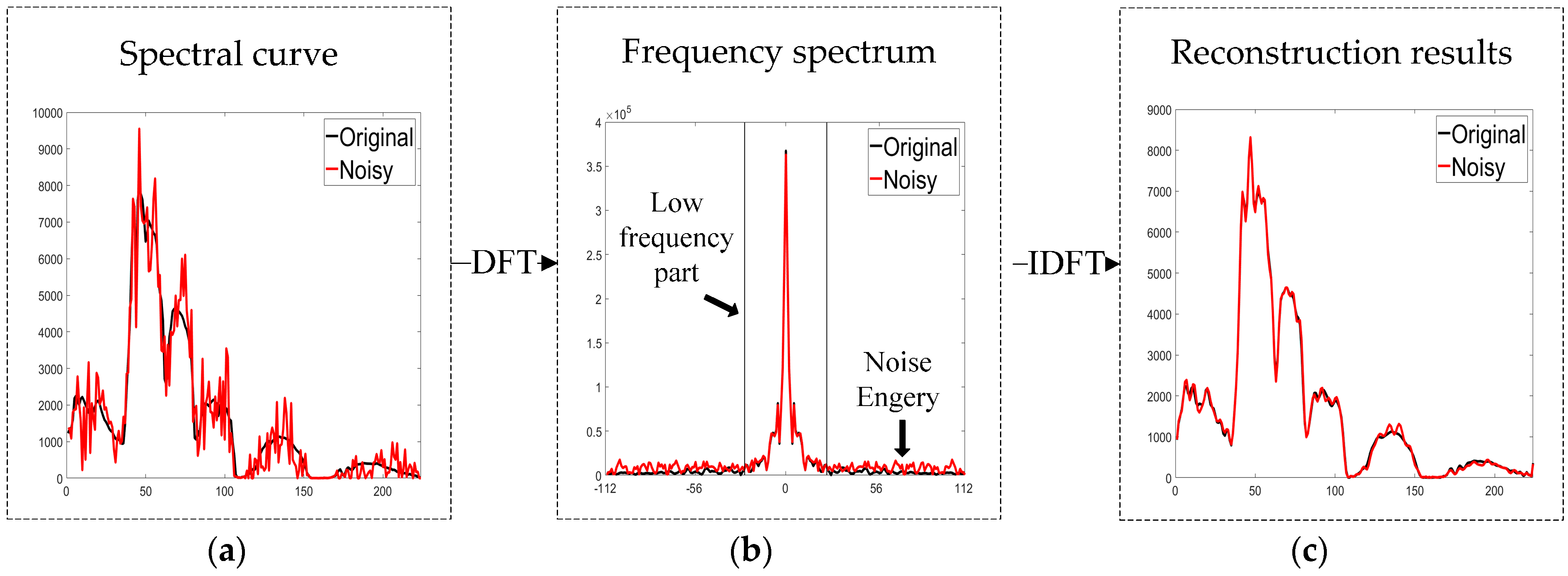

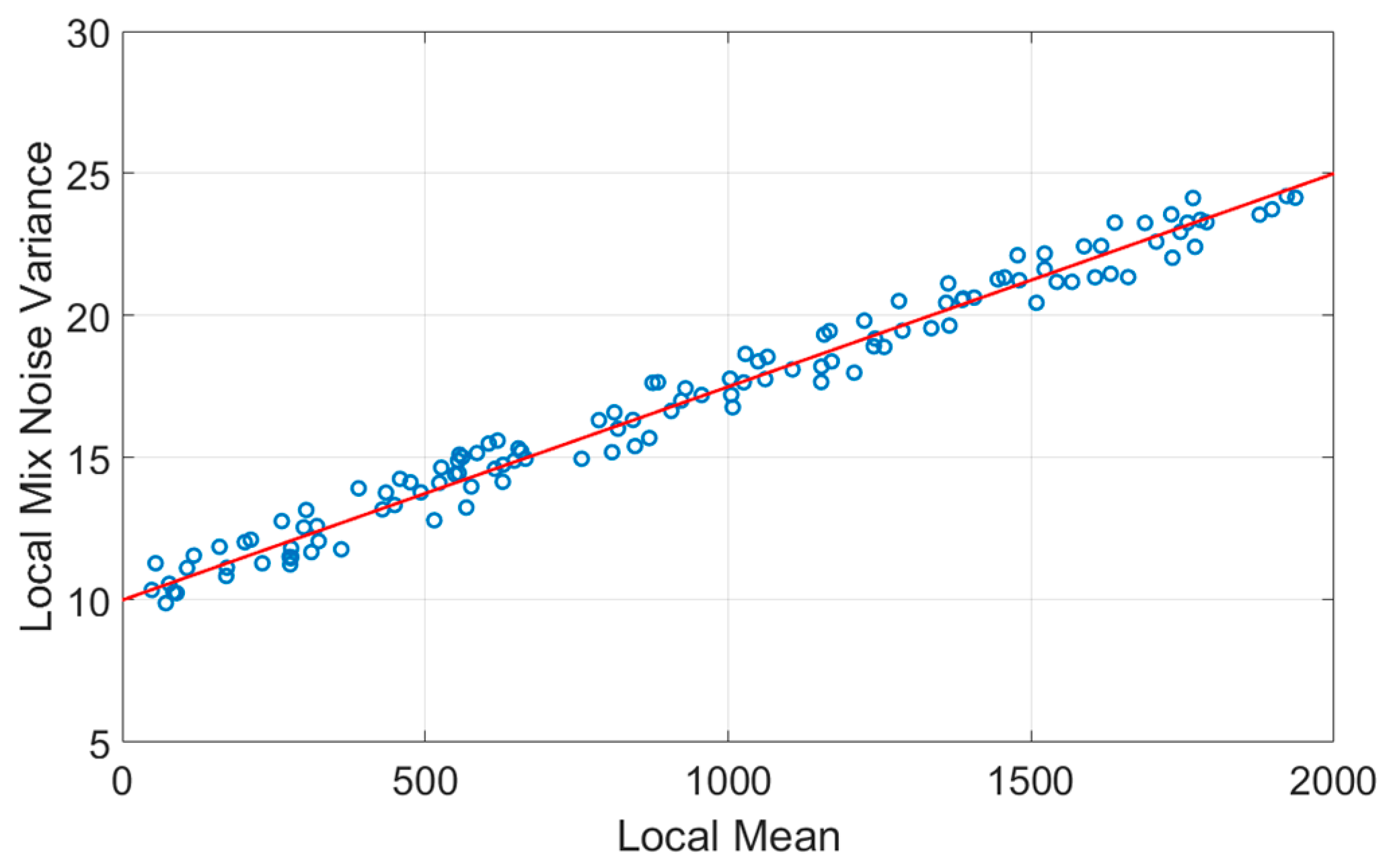
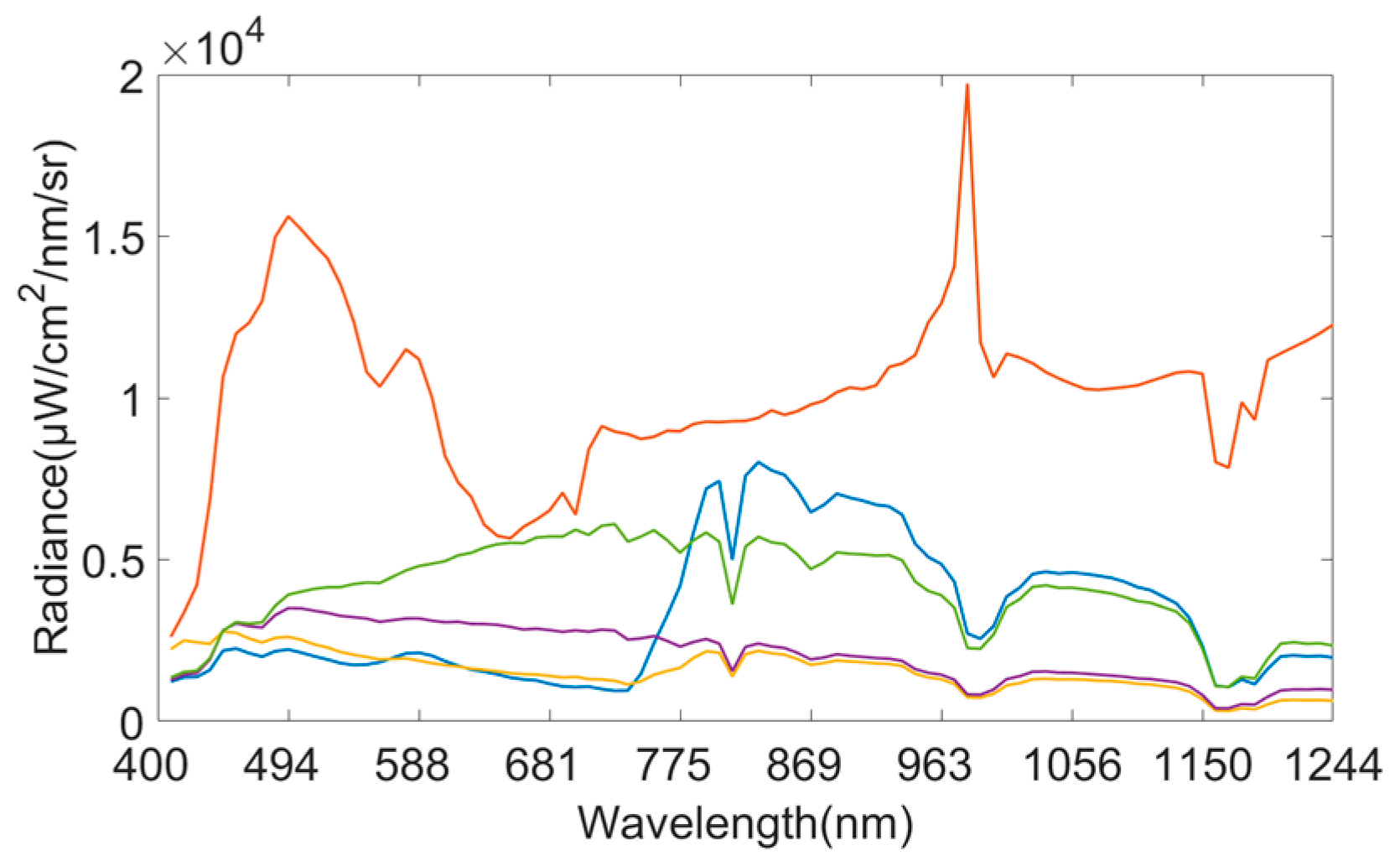


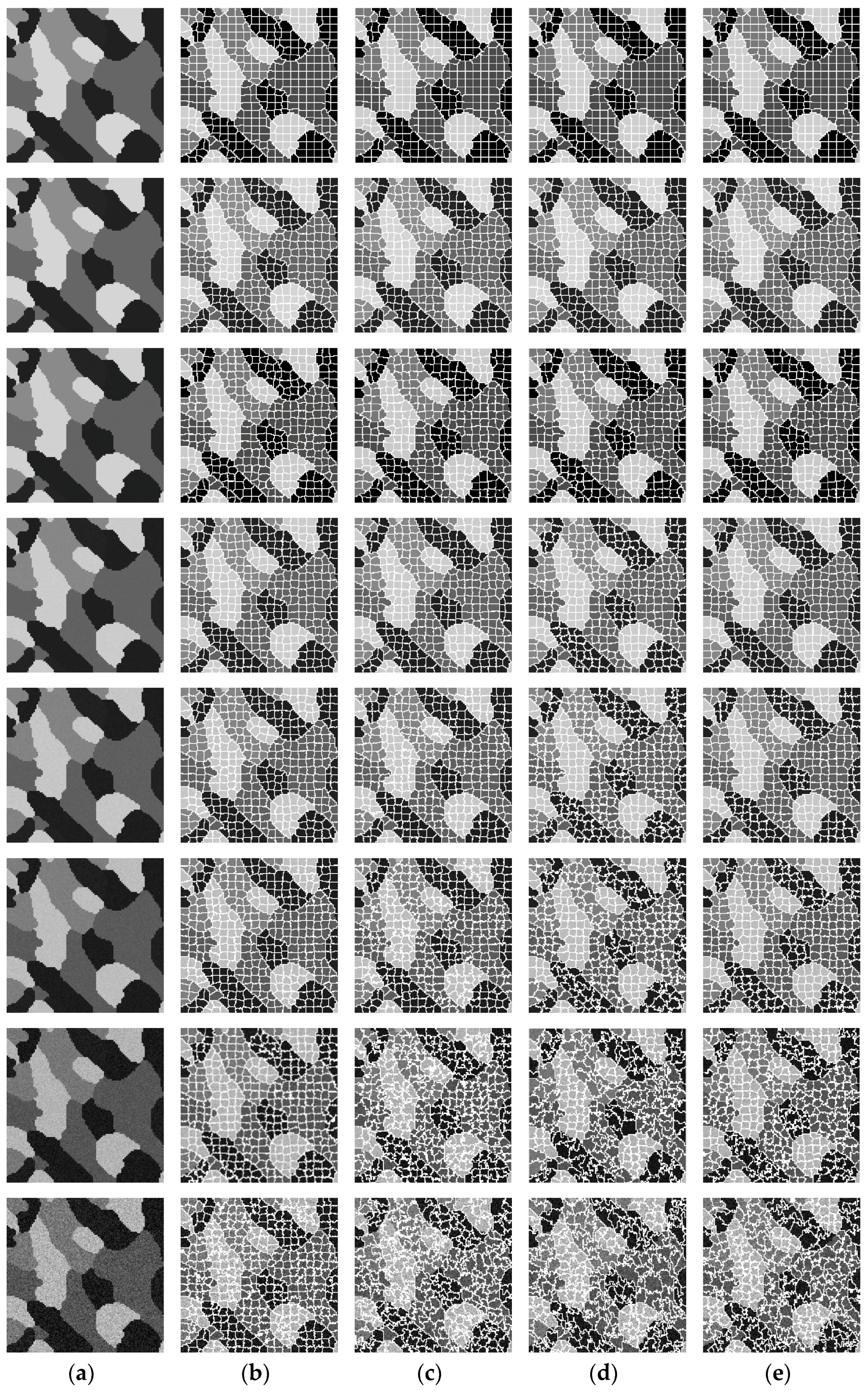
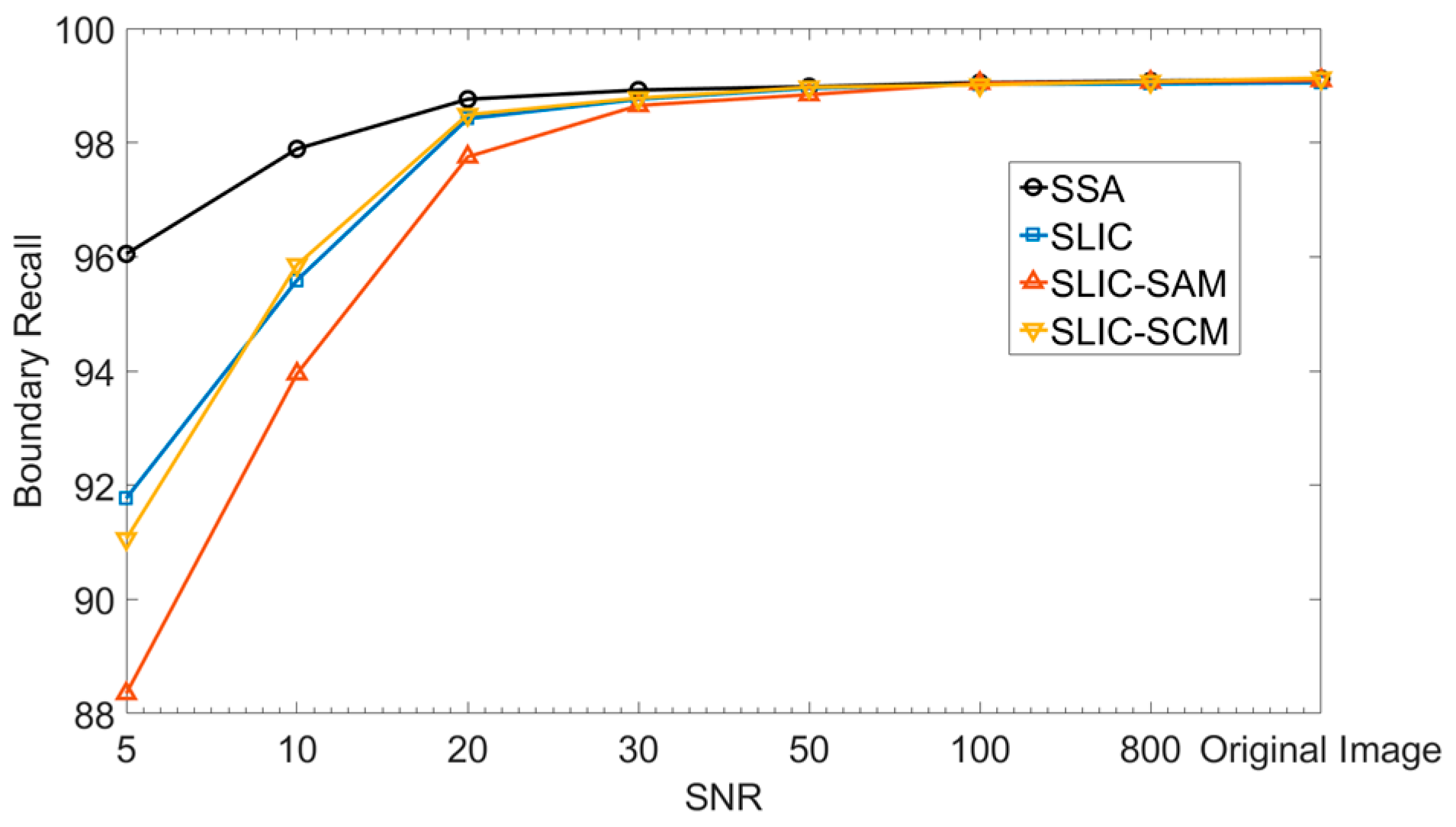
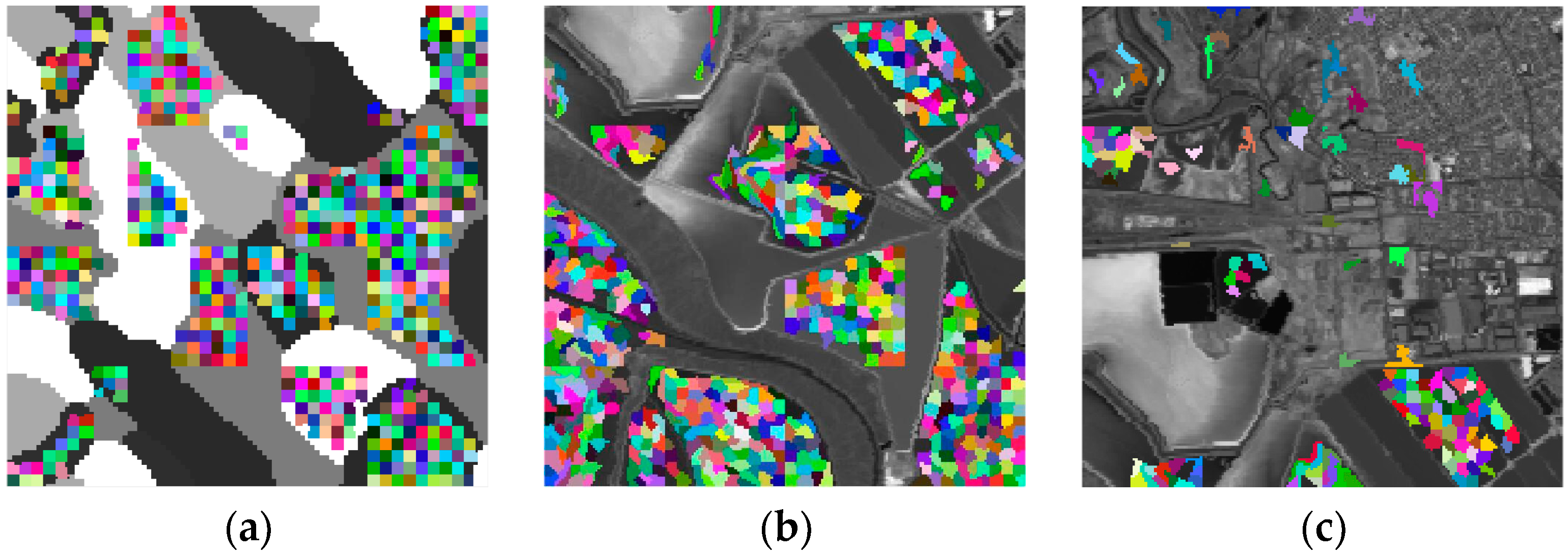
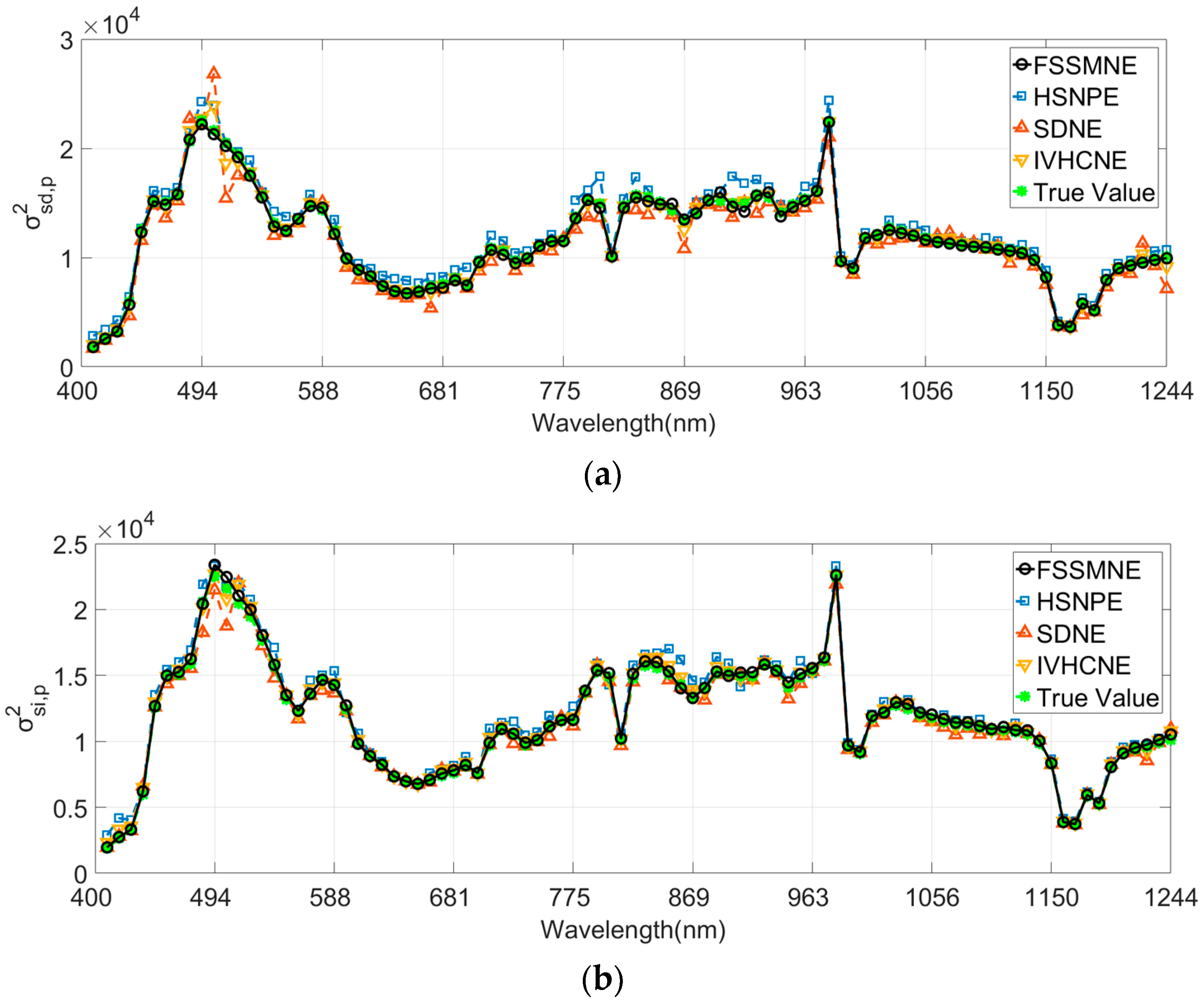

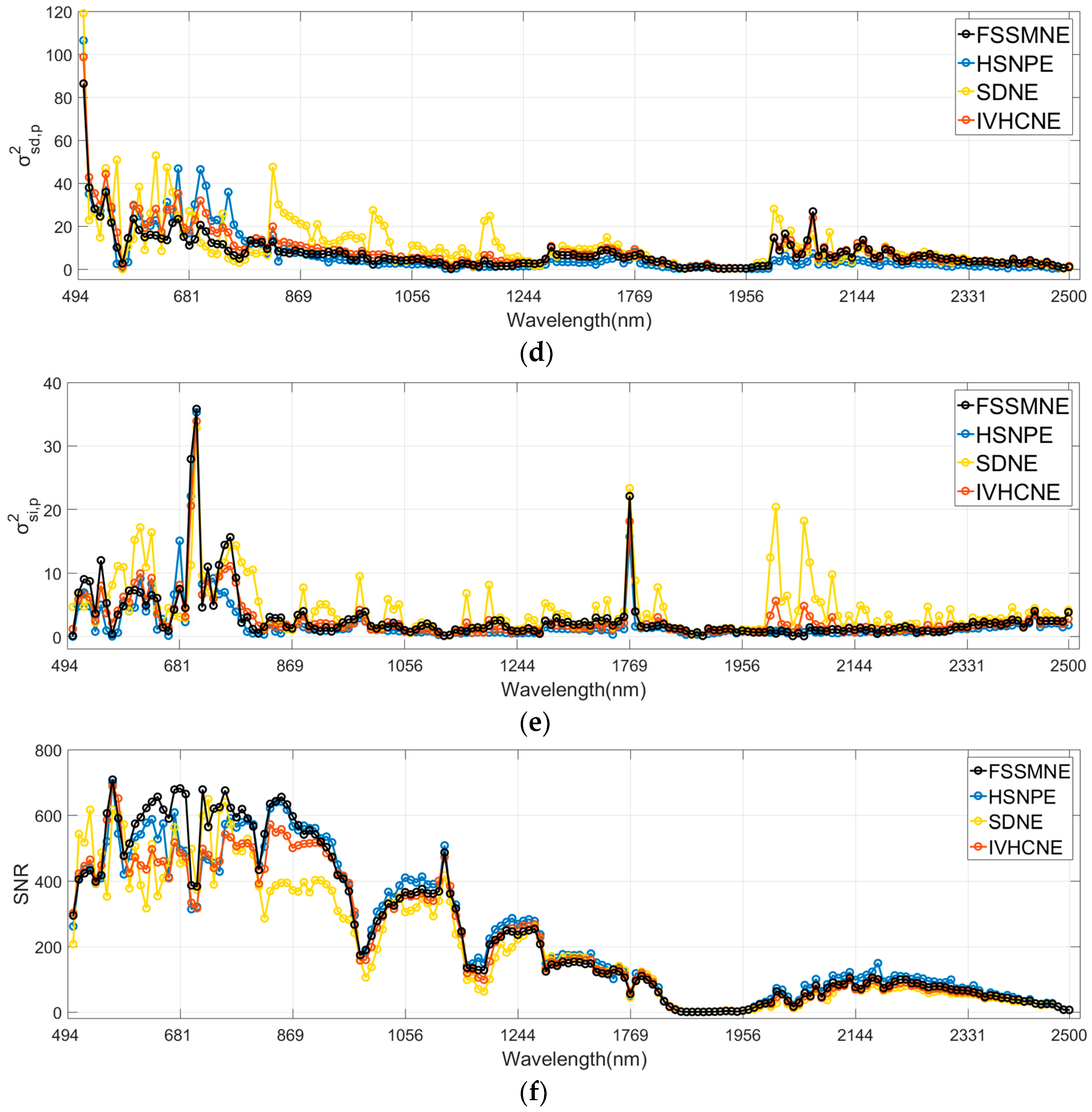
| Methods | FSSMNE | HSNPE | SDNE | IVHCNE |
|---|---|---|---|---|
| 8.2 × 10−4 | 6.8 × 10−3 | 6.7 × 10−3 | 2.0 × 10−3 | |
| 6.2 × 10−4 | 9.5 × 10−3 | 1.6 × 10−3 | 9.9 × 10−4 |
| 5 | 10 | 20 | 30 | 50 | 100 | 800 | |
|---|---|---|---|---|---|---|---|
| 2.7 × 10−2 | 7.8 × 10−3 | 1.5 × 10−3 | 8.2 × 10−4 | 8.1 × 10−4 | 8.0 × 10−4 | 8.0 × 10−4 | |
| 2.5 × 10−2 | 6.4 × 10−3 | 1.9 × 10−3 | 6.2 × 10−4 | 5.9 × 10−4 | 5.5 × 10−4 | 5.3 × 10−4 |
| 1/4 | 1/3 | 1/2 | 1 | 2 | 3 | 4 | |
|---|---|---|---|---|---|---|---|
| 2.5 × 10−3 | 1.9 × 10−3 | 1.4 × 10−3 | 8.2 × 10−4 | 7.4 × 10−4 | 7.3 × 10−4 | 5.6 × 10−4 | |
| 5.1 × 10−4 | 7.0 × 10−4 | 7.6 × 10−4 | 6.2 × 10−4 | 9.7 × 10−4 | 1.8 × 10−3 | 2.4 × 10−3 |
| Methods | FSSMNE | HSNPE | SDNE | IVHCNE |
|---|---|---|---|---|
| 1.545 | 1.302 | 9.242 | 3.710 | |
| 0.770 | 0.409 | 4.045 | 1.209 | |
| 44.612 | 30.716 | 78.234 | 60.301 |
© 2017 by the authors. Licensee MDPI, Basel, Switzerland. This article is an open access article distributed under the terms and conditions of the Creative Commons Attribution (CC BY) license (http://creativecommons.org/licenses/by/4.0/).
Share and Cite
Fu, P.; Sun, X.; Sun, Q. Hyperspectral Image Segmentation via Frequency-Based Similarity for Mixed Noise Estimation. Remote Sens. 2017, 9, 1237. https://doi.org/10.3390/rs9121237
Fu P, Sun X, Sun Q. Hyperspectral Image Segmentation via Frequency-Based Similarity for Mixed Noise Estimation. Remote Sensing. 2017; 9(12):1237. https://doi.org/10.3390/rs9121237
Chicago/Turabian StyleFu, Peng, Xin Sun, and Quansen Sun. 2017. "Hyperspectral Image Segmentation via Frequency-Based Similarity for Mixed Noise Estimation" Remote Sensing 9, no. 12: 1237. https://doi.org/10.3390/rs9121237





